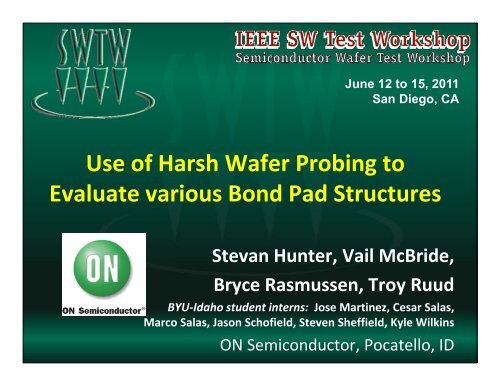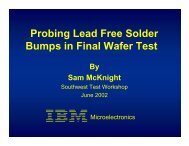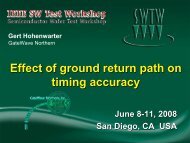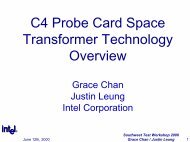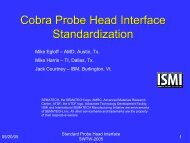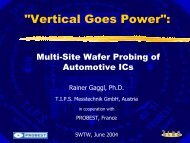Use of Harsh Wafer Probing to Evaluate Various Bond Pad Structures
Use of Harsh Wafer Probing to Evaluate Various Bond Pad Structures
Use of Harsh Wafer Probing to Evaluate Various Bond Pad Structures
Create successful ePaper yourself
Turn your PDF publications into a flip-book with our unique Google optimized e-Paper software.
June 12 <strong>to</strong> 15, 2011<br />
San Diego, CA<br />
<strong>Use</strong> <strong>of</strong> <strong>Harsh</strong> <strong>Wafer</strong> <strong>Probing</strong> <strong>to</strong><br />
<strong>Evaluate</strong> various <strong>Bond</strong> <strong>Pad</strong> <strong>Structures</strong><br />
Stevan Hunter, Vail McBride,<br />
Bryce Rasmussen, Troy Ruud<br />
BYU‐Idaho student interns: Jose Martinez, Cesar Salas,<br />
Marco Salas, Jason Sch<strong>of</strong>ield, Steven Sheffield, Kyle Wilkins<br />
ON Semiconduc<strong>to</strong>r, Pocatello, ID
Outline<br />
• The need for more robust bond pads<br />
• <strong>Harsh</strong> probing experiments on traditional bond<br />
pads<br />
• <strong>Harsh</strong> probing on experimental pad structures<br />
• Discussion <strong>of</strong> results, theory<br />
• Crack prevention in wafer probe by pad design<br />
• Summary<br />
• Future work<br />
• Acknowledgements<br />
June 12 <strong>to</strong> 15, 2011<br />
IEEE SW Test Workshop 2
The need for more robust bond pads<br />
Product needs:<br />
• bond‐over‐active‐circuitry (BOAC)<br />
• maximum pad design flexibility for small die size, “pad anywhere”<br />
• 2 – 7 levels <strong>of</strong> metal<br />
• interconnect circuitry in all levels below the pad metal, (& ESD protection)<br />
• metal deformation and pad cracks are not acceptable<br />
• thick <strong>to</strong>p metal is generally not an option<br />
• Cu wirebond <strong>to</strong> replace Au wirebond<br />
• increased stress <strong>to</strong> pad structure<br />
• low force wafer probe<br />
• up <strong>to</strong> 6 probe <strong>to</strong>uchdowns (NVM, high and low temp. testing, …)<br />
• higher reliability<br />
• traditional pad structure cracks easily in both probe and bond<br />
• … while decreasing cost<br />
‣ Need “robust” bond pads, new bond pad design rules !<br />
June 12 <strong>to</strong> 15, 2011<br />
IEEE SW Test Workshop 3
Traditional bond pads in tests<br />
A 4-level metal pad structure within the<br />
“pad window” is illustrated in concept:<br />
Al metallization: TiN / Al(0.5%Cu) / TiN,<br />
Wvias vias, SiO 2 dielectric<br />
• sheets <strong>of</strong> metallization at all levels<br />
• via arrays connecting the plates<br />
• SiO 2 dielectric i surrounding<br />
<strong>Pad</strong> Al (MT)<br />
<strong>to</strong>p vias MT(-1)<br />
MT(-2)<br />
MT(-3)<br />
(Periphery <strong>of</strong> pad structure,<br />
passivation, Si devices, etc. are not<br />
shown)<br />
June 12 <strong>to</strong> 15, 2011<br />
IEEE SW Test Workshop 4
“Cratering Test”<br />
• Cratering Test t( (removal <strong>of</strong> pad Al, then visual linspect)<br />
– Etch in KOH or “PAN etch” (phosphoric‐acetic‐nitric) solution<br />
<strong>to</strong> remove Al from pad, but purposely leave some <strong>of</strong> the TiN<br />
barrier film in place<br />
– visually observe <strong>to</strong>p SiO 2 cracking<br />
– visually observe other damage: “lifting barrier”, other loss <strong>of</strong><br />
adhesion, craters<br />
– optical “ripple effect”<br />
• deformation in underlying metal interconnect (verify by FIB or XSEM)<br />
–not all damage can be seen by cratering test<br />
• cannot detect weakened locations<br />
• may not see cracks in SiO 2 if the TiN barrier is not broken<br />
• cannot detect partially cracked locations on the bot<strong>to</strong>m <strong>of</strong> the SiO 2<br />
June 12 <strong>to</strong> 15, 2011<br />
IEEE SW Test Workshop 5
<strong>Pad</strong> Damage Concerns<br />
Probe damage on bond pads can lead d<strong>to</strong>:<br />
• poor wirebond<br />
– large area, depth <strong>of</strong> gouge<br />
–cracks that weaken the bond<br />
– film loss <strong>of</strong> adhesion<br />
• long term reliability concerns<br />
– (the above)<br />
–(for Au wirebond) non‐uniform voiding or resistance issues<br />
relating <strong>to</strong> intermetallic compound difference at probe<br />
location<br />
–cracks cause leakage or shorts in BOAC<br />
– cracks may widen or propagate during assembly, and in use<br />
June 12 <strong>to</strong> 15, 2011<br />
IEEE SW Test Workshop 6
Cratering test example pho<strong>to</strong>s<br />
• Cratering test removes the pad Al and the probe mark<br />
• Usually etch only the Al <strong>to</strong> leave TiN barrier<br />
–easier <strong>to</strong> see the cracks (highlighted in red below)<br />
• Can also overetch the TiN <strong>to</strong> reveal etch damage in the<br />
underlying metal layer<br />
<strong>Pad</strong> 1 <strong>Pad</strong> 2 <strong>Pad</strong>3 <strong>Pad</strong> 4 <strong>Pad</strong> 5 <strong>Pad</strong> 6<br />
Probe<br />
Mark<br />
Normal<br />
Etched<br />
Over<br />
Etched<br />
June 12 <strong>to</strong> 15, 2011<br />
IEEE SW Test Workshop 7
Damage relating <strong>to</strong> <strong>to</strong>p vias<br />
• <strong>to</strong>p vias participate in SiO 2 cracking, giving traditional<br />
pads with <strong>to</strong>p vias the worst record for cracking<br />
• lifting TiN, SiO 2 divots, and craters are much more<br />
likely with <strong>to</strong>p vias<br />
cracks propagate from via <strong>to</strong> via<br />
an example <strong>of</strong> “lifting barrier”,<br />
relating <strong>to</strong> <strong>to</strong>p vias<br />
June 12 <strong>to</strong> 15, 2011<br />
IEEE SW Test Workshop 8
Proposed experiments<br />
Assume: if a pad structure can withstand harsh probing without<br />
cracking, it will be more robust in wirebond as well …<br />
Plan: Experiment with traditional pads and choose a “harsh”<br />
probing condition, then probe “harsh” on pad design variations<br />
– Cantilever probe cards<br />
– WRe probe tips, 0.8 mil diameter, ~105 degree bend angle<br />
– TSK UF‐200 prober<br />
– sample: at least 40 pads per die, at least 3 die per condition<br />
fac<strong>to</strong>r abrev levelsl<br />
chuck overdrive OD 1, 2, 3, 4 mils<br />
number <strong>of</strong> <strong>to</strong>uchdowns TD 1, 2, 6<br />
probe tip length TL 17.5, 28.5 mils<br />
<strong>to</strong>p metal Al thick MT 0.55, 0.8, 1, 1.5, 3 um<br />
<strong>to</strong>p vias VT dense, , sparse, none<br />
June 12 <strong>to</strong> 15, 2011<br />
IEEE SW Test Workshop 9
Traditional bond pads after harsh probing<br />
1. Chuck overdrive is the strongest fac<strong>to</strong>r for cracking<br />
2. Probe <strong>to</strong>uchdowns is a strong fac<strong>to</strong>r when high overdrive<br />
3. Short probe tips are worse for cracking<br />
• (Thick <strong>to</strong>p metal >1um reduces cracking)<br />
Traditional pads probed at 4mils OD, 6 TDs<br />
data combined from many experiments, 4 different technologies<br />
traditional pad design % pads cracked: 6 TD, 4mil OD Ripple effect other damage<br />
0.55um MT, dense VT 95 ‐ 100 % strong some barrier lifting<br />
0.8um MT, dense VT 90 ‐ 100 % strong some barrier lifting<br />
0.55um MT, no VT 60 –90 % strong<br />
0.8um MT, no VT 40 – 90 % strong<br />
1.0um MT, no VT 20 ‐ 50 % strong<br />
1.5um MT, no VT 15 ‐ 25% reduced<br />
3.0um MT, no VT 0 barely visible<br />
June 12 <strong>to</strong> 15, 2011<br />
IEEE SW Test Workshop 10
Examples <strong>of</strong> pad crack pho<strong>to</strong>s<br />
overlaid with the probe marks<br />
June 12 <strong>to</strong> 15, 2011<br />
IEEE SW Test Workshop 11
Crack initiation from probing<br />
• This FIB cross section <strong>of</strong> a probe mark on a traditional<br />
pad structure shows 4 cracks in the <strong>to</strong>p dielectric<br />
– 3 cracks initiate i i in the bot<strong>to</strong>m <strong>of</strong> the dielectric<br />
i<br />
–cracks are located near the deepest part <strong>of</strong> the probe mark<br />
– only one is easily visible in a cratering test: cracked TiN<br />
–cracks will become worse (propagate, widen) during wirebond<br />
(sample prep material)<br />
<strong>Pad</strong> Al<br />
Top IMD (CVD SiO 2 )<br />
Top Vias<br />
<strong>Pad</strong> Al<br />
MT(-1) Al<br />
June 12 <strong>to</strong> 15, 2011<br />
IEEE SW Test Workshop 12
P M Area<br />
Chuck overdrive<br />
• Chuck overdrive increase is the largest fac<strong>to</strong>r in<br />
causing cracks for traditional bond pads<br />
800<br />
700<br />
600<br />
500<br />
400<br />
300<br />
– probe mark size increases<br />
–probe mark depth increases<br />
–% <strong>of</strong> pads cracked increases<br />
– number and length <strong>of</strong> cracks increases<br />
Probe Mark Area<br />
2mils OD 3mils OD 4mils OD<br />
200<br />
100<br />
2 3 4<br />
250 µ² 320 µ² 510 µ²<br />
OD<br />
(mils)<br />
June 12 <strong>to</strong> 15, 2011<br />
IEEE SW Test Workshop 13
Number <strong>of</strong> <strong>to</strong>uchdowns<br />
• Probe <strong>to</strong>uchdowns is not a large<br />
fac<strong>to</strong>r in cracking until the overdrive<br />
is high h on traditional pads<br />
• crack length and number <strong>of</strong> cracks<br />
increase with more <strong>to</strong>uchdowns<br />
Crack (0/1)<br />
Crack (0/1)<br />
Crack (0 0/1)<br />
1.1<br />
1.0<br />
0.9<br />
0.8<br />
0.7<br />
0.6<br />
0.5<br />
0.4<br />
0.3<br />
0.2<br />
0.1<br />
00 0.0<br />
-0.1<br />
Fraction <strong>of</strong> Cracked <strong>Pad</strong>s<br />
vs # Touchdowns<br />
2mils OD<br />
1 2 6<br />
1.1<br />
1.0 # <strong>of</strong> Touches<br />
0.9<br />
0.8<br />
0.7<br />
0.6<br />
0.5<br />
0.4 3mils OD<br />
03 0.3<br />
0.2<br />
0.1<br />
0.0<br />
-0.1<br />
1 2 6<br />
1.1<br />
1.0 # <strong>of</strong> Touches<br />
0.9<br />
0.8<br />
0.7<br />
0.6 4mils OD<br />
0.5<br />
0.4<br />
0.3<br />
0.2<br />
0.1<br />
0.0<br />
-0.1<br />
2 6<br />
# <strong>of</strong> Touches<br />
below: cracks in cratering test are superimposed on probe mark pho<strong>to</strong>s<br />
1 TD 2 TD 6 TD<br />
June 12 <strong>to</strong> 15, 2011<br />
IEEE SW Test Workshop 14
Probe tip length<br />
• shorter tip length causes<br />
more cracks, most apparent<br />
with high <strong>to</strong>uchdowns on<br />
traditional pads<br />
• shorter tip length causes<br />
longer probe mark<br />
Long Probe Tip<br />
(28.5 mils)<br />
Short Probe Tip<br />
(17.5 mils)<br />
4 mils overdrive, 2 TDs<br />
4 mils overdrive, 2 TDs<br />
Fraction %Of <strong>of</strong> Cac Cracked <strong>Pad</strong>s<br />
<strong>Pad</strong>s<br />
6 TD’s<br />
2 TD’s<br />
Short Long Short Long<br />
P M Length<br />
50<br />
40<br />
30<br />
20<br />
10<br />
Probe mark Length<br />
17.5<br />
28.5<br />
17.5<br />
28.5<br />
17.5<br />
28.5<br />
17.5<br />
28.5<br />
17.5<br />
28.5<br />
17.5<br />
28.5<br />
17.5<br />
28.5<br />
17.5<br />
28.5<br />
1 2 6 1 2 6 2 6 TDs<br />
Tip Length<br />
1342 Data Points 2 3 4 OD<br />
June 12 <strong>to</strong> 15, 2011<br />
IEEE SW Test Workshop 15
800<br />
700<br />
600<br />
500<br />
400<br />
main fac<strong>to</strong>rs interactions for traditional pads<br />
example data from one experiment<br />
1.1<br />
Probe Mark Area Fraction <strong>of</strong> Cracked <strong>Pad</strong>s<br />
1.0<br />
0.9<br />
0.8<br />
0.7<br />
0.6<br />
0.5<br />
0.4<br />
03 0.3<br />
0.2<br />
Pr<br />
robe Mark Area<br />
17.5<br />
28.5<br />
17.5<br />
28.5<br />
17.5<br />
28.5<br />
17.5<br />
28.5<br />
17.5<br />
28.5<br />
17.5<br />
28.5<br />
17.5<br />
28.5<br />
17.5<br />
28.5<br />
Crack (0/1)<br />
300<br />
200<br />
100<br />
Probe Length<br />
0.1<br />
0.0<br />
-0.1<br />
Probe Length<br />
17.5<br />
28.5<br />
17.5<br />
28.5<br />
17.5<br />
28.5<br />
17.5<br />
28.5<br />
17.5<br />
28.5<br />
17.5<br />
28.5<br />
17.5<br />
28.5<br />
17.5<br />
28.5<br />
1 2 6 1 2 6 2 6 # <strong>of</strong> f Touches T h<br />
1 2 6 1 2 6 2 6 # <strong>of</strong> f Touches T h<br />
15<br />
Total Length <strong>of</strong> Crack<br />
Number <strong>of</strong> Cracks<br />
150<br />
100<br />
50<br />
2 3 4 Chuck Overdrive<br />
2 3 4 Chuck Overdrive (mils)<br />
Crack Length Number <strong>of</strong> Cracks in a <strong>Pad</strong><br />
10<br />
5<br />
0<br />
Probe Length<br />
17.5<br />
28.5<br />
17.5<br />
28.5<br />
17.5<br />
28.5<br />
17.5<br />
28.5<br />
17.5<br />
28.5<br />
17.5<br />
28.5<br />
17.5<br />
28.5<br />
17.5<br />
28.5<br />
17.5<br />
28.5<br />
17.5<br />
28.5<br />
17.5<br />
28.5<br />
17.5<br />
28.5<br />
17.5<br />
28.5<br />
17.5<br />
28.5<br />
17.5<br />
28.5<br />
17.5<br />
28.5<br />
0<br />
Probe Length<br />
1 2 6 1 2 6 2 6 # <strong>of</strong> Touches<br />
1 2 6 1 2 6 2 6 # <strong>of</strong> Touches<br />
2 3 4 Chuck Overdrive<br />
2 3 4 Chuck Overdrive (mils)<br />
June 12 <strong>to</strong> 15, 2011 IEEE SW Test Workshop 16
<strong>Pad</strong> Al thickness<br />
• Cracking reduces with increasing pad Al thickness<br />
• harsh probing conditions reveal this dramatic trend<br />
• pad Al thickness <strong>of</strong> 3um prevents cracks from harsh probe<br />
Example experiment data below is from two different technologies;<br />
No <strong>to</strong>p vias, 6 Touchdowns at 4mils Overdrive<br />
June 12 <strong>to</strong> 15, 2011<br />
IEEE SW Test Workshop 17
Crack characteristics<br />
• Cracks (red) tend <strong>to</strong> form with a radius the<br />
same as the probe tip (blue)<br />
Probe Mark from<br />
Long Probe Tip,<br />
no <strong>to</strong>p vias<br />
Probe Mark from<br />
Short Probe Tip,<br />
with <strong>to</strong>p vias<br />
Direction<br />
<strong>of</strong> probe<br />
scrub<br />
June 12 <strong>to</strong> 15, 2011<br />
IEEE SW Test Workshop 18
<strong>Harsh</strong> bonding experiment plan:<br />
fac<strong>to</strong>r<br />
pad structure variations<br />
levels<br />
PdAl <strong>Pad</strong> .55um .8um 10 1.0um 15 1.5um 30 3.0um<br />
Top Vias (Dense) sparse none<br />
MT(‐1) sheet dummy<br />
fill<br />
MT(‐2) sheet dummy<br />
fill<br />
wide<br />
slots<br />
wide<br />
slots<br />
large<br />
holes<br />
large<br />
holes<br />
small<br />
holes<br />
small<br />
holes<br />
no metal<br />
no metal<br />
MT(‐3) sheet wide no metal<br />
slots<br />
Interconnect layers’ metal pattern “density” in the pad window = 100% for a<br />
full sheet, or reduced density values when slots or holes are placed in the<br />
metal, or 0% for no metal at all in the pad window.<br />
June 12 <strong>to</strong> 15, 2011<br />
IEEE SW Test Workshop 19
The effect <strong>of</strong> a full metal sheet below<br />
pad window (ignoring <strong>to</strong>p vias)<br />
• Ripple effect from probing is seen “worst” anytime<br />
there is a full sheet <strong>of</strong> metal beneath the pad window<br />
• Cracking occurs “worst” anytime there is a full sheet <strong>of</strong><br />
metal<br />
–MT(‐1) sheet: largest ripple, and highest % pads cracked<br />
– MT(‐2) sheet, missing or pattern in MT(‐1): reduced ripple,<br />
and order <strong>of</strong> magnitude fewer pads cracked<br />
– MT(‐3) sheet, missing or pattern in MT(‐1 1, ‐2): further<br />
reduced ripple, and another order <strong>of</strong> magnitude fewer pads<br />
cracked<br />
June 12 <strong>to</strong> 15, 2011<br />
IEEE SW Test Workshop 20
Ripple effect from wafer probe<br />
• ripple effect seen in cratering test, due <strong>to</strong> underlying Al<br />
deformation and bending <strong>of</strong> SiO 2<br />
• (<strong>of</strong>ten has the appearance <strong>of</strong> ripples on a pond)<br />
• the pad on the right has slots in MT(‐1): no ripple, and<br />
greatly reduced cracking tendency<br />
• ripple effect correlates well with cracking<br />
• ripple is best observed with differential interference<br />
contrast (DIC) microscope<br />
ripple effect is only visible on the 6 pads having full metal sheets below<br />
slots in<br />
MT(-1)<br />
June 12 <strong>to</strong> 15, 2011<br />
IEEE SW Test Workshop 21
Summary <strong>Bond</strong> <strong>Pad</strong> Structure Cracking Results:<br />
6 <strong>to</strong>uchdowns at 4mils overdrive<br />
X<br />
X<br />
Weakest Slight improvement More improvement<br />
Better Better Very good<br />
X<br />
X<br />
X<br />
Very good<br />
June 12 <strong>to</strong> 15, 2011<br />
X<br />
Very good<br />
X<br />
X X<br />
X<br />
Strongest<br />
IEEE SW Test Workshop 22
MT(‐1) experimental design examples<br />
• After cratering test, cracks are visible in the TiN barrier<br />
• MT(‐1) patterns can be seen, after removal <strong>of</strong> pad Al and TiN<br />
barrier film<br />
Cracks visible after cratering test on various design examples<br />
Extra cratering etch reveals MT(‐1) patterns (not the same pads as above)<br />
full sheet, full sheet,<br />
no vias<br />
no <strong>to</strong>p vias,<br />
slots diagonal slots slots<br />
under<br />
but dense<br />
worst for<br />
vias under<br />
cracking<br />
June 12 <strong>to</strong> 15, 2011<br />
IEEE SW Test Workshop 23
MT(‐1) experimental design examples<br />
• More MT(‐1) patterns can be seen, after removal <strong>of</strong><br />
pad Al and TiN barrier film<br />
<strong>Various</strong> MT(‐1) patterns: arrays <strong>of</strong> holes<br />
best for<br />
crack<br />
prevention<br />
June 12 <strong>to</strong> 15, 2011<br />
IEEE SW Test Workshop 24
<strong>Harsh</strong> Probe Data Experimental <strong>Bond</strong> <strong>Pad</strong>s<br />
Fraction <strong>of</strong> Cracked <strong>Pad</strong>s vs. Metal Pattern Density <strong>of</strong> MT(-1)<br />
June 12 <strong>to</strong> 15, 2011<br />
IEEE SW Test Workshop 25
<strong>Pad</strong>s cracked vs MT(‐1) pattern<br />
June 12 <strong>to</strong> 15, 2011<br />
IEEE SW Test Workshop 26
Crack interaction with MT(‐1) dummy pattern<br />
• cracks from harsh<br />
probing with dummy fill<br />
pattern in MT(‐1)<br />
• cracks initiate at the<br />
transition <strong>of</strong> space <strong>to</strong><br />
metal<br />
– (the pattern is very<br />
difficult <strong>to</strong> see in pho<strong>to</strong>s,<br />
but this interaction is<br />
observed routinely)<br />
transition<br />
mid-metal<br />
June 12 <strong>to</strong> 15, 2011<br />
IEEE SW Test Workshop 27
Crack interaction with slots<br />
• crack initiates above the metal (light orange)<br />
• crack propagates normally until the edge <strong>of</strong> the metal<br />
• propagation in the “space” changes direction<br />
– tends <strong>to</strong> be more parallel <strong>to</strong> the metal edge<br />
MT(-1)<br />
MT(-1)<br />
MT(-1)<br />
space<br />
space<br />
June 12 <strong>to</strong> 15, 2011<br />
IEEE SW Test Workshop 28
Crack interaction with diagonal slots<br />
• crack initiates above the diagonal metal (light orange)<br />
• crack propagates normally until the edge <strong>of</strong> the metal<br />
• propagation in the “space” changes direction<br />
– tends <strong>to</strong> be either perpendicular or parallel <strong>to</strong> the metal edge<br />
MT(-1)<br />
MT(-1)<br />
space<br />
MT(-1)<br />
space<br />
June 12 <strong>to</strong> 15, 2011<br />
IEEE SW Test Workshop 29
Discussion <strong>of</strong> results for harsh probing<br />
• fac<strong>to</strong>rs <strong>of</strong> Overdrive, Touchdowns, and Probe Tip Length on<br />
traditional pads show the well known effects<br />
• increasing pad Al thickness reduces cracks from harsh probing<br />
• full sheet in MT(‐1) appears <strong>to</strong> be a root cause <strong>of</strong> cracks from<br />
probe<br />
• <strong>to</strong>p vias weaken the SiO 2 even more and cause more cracking<br />
• ripple effect tracks cracking – a witness <strong>of</strong> underlying films<br />
deformation<br />
• cracking reduces when underlying metal density is lower,<br />
especially in MT(‐1)<br />
• cracking further reduces when MT(‐1) width is small between<br />
spaces, slots or holes<br />
• cracks interact with MT(‐1) pattern<br />
June 12 <strong>to</strong> 15, 2011<br />
IEEE SW Test Workshop 30
illustrations <strong>to</strong> explain probe‐pattern<br />
probe tip “heel”<br />
interaction<br />
SiO 2<br />
Al<br />
scrub<br />
direction<br />
June 12 <strong>to</strong> 15, 2011<br />
IEEE SW Test Workshop 31
Illustrations <strong>to</strong> show actual crack<br />
interaction with MT(‐1) patterns<br />
SiO 2<br />
Al<br />
scrub<br />
direction<br />
June 12 <strong>to</strong> 15, 2011<br />
IEEE SW Test Workshop 32
What causes the cracks ?<br />
Proposed cracking mechanism:<br />
• 1.) A predominantly downward force from the probe causes the pad Al <strong>to</strong> undergo<br />
plastic deformation (the probe mark) when its yield strength is exceeded (Al is weak<br />
in compression).<br />
• 2.) Some <strong>of</strong> the probe stress reaches the <strong>to</strong>p dielectric i and any <strong>to</strong>p vias in the vicinity. iii<br />
• 3.) The SiO 2 will compress elastically like the Al, having a similar elastic modulus, but<br />
the W vias will not due <strong>to</strong> the much higher elastic modulus, resulting in extra local<br />
stress within the SiO 2 at the <strong>to</strong>p via positions. SiO 2 is strong in compression and<br />
would not be expected <strong>to</strong> yield (crack) from the downforce unless it is allowed <strong>to</strong><br />
bend.<br />
• 4.) Probe stress that reaches the MT(‐1) will compress the Al elastically (and<br />
plastically if high stress) in<strong>to</strong> a local “valley” (with local “hills” forming nearby due <strong>to</strong><br />
the displaced Al material). The deforming Al <strong>of</strong> MT(‐1) is expected <strong>to</strong> absorb the<br />
majority <strong>of</strong> the stress such that any films below it will not be deformed.<br />
• 5) 5.) SiO 2 <strong>to</strong>p dielectric i bends in<strong>to</strong> the “valley” <strong>of</strong> compressed MT(‐1) Al, and a crack<br />
will easily initiate at the bot<strong>to</strong>m due <strong>to</strong> the high tensile stress at that surface.<br />
• 6.) The crack or cracks may then propagate upwards in the SiO 2 during probing or in<br />
later processing or thermal cycling, breaking the upper SiO 2 surface and the TiN<br />
barrier <strong>to</strong> become visible in a “cratering test”.<br />
June 12 <strong>to</strong> 15, 2011<br />
IEEE SW Test Workshop 33
Crack initiation from probing<br />
Proposed crack mechanism<br />
1. region A films in compression during probe scrub<br />
– cracks 1, 2, 3 initiate at bot<strong>to</strong>m <strong>of</strong> SiO 2 film from high tension as SiO 2<br />
bends in a “u” shape following the temporary Al “valley” ”in MT(‐1)<br />
2. location B becomes a local maximum in MT(‐1) Al thickness<br />
due <strong>to</strong> continued probe scrub action<br />
– crack 4 initiates at <strong>to</strong>p <strong>of</strong> SiO 2 , cracking the pad barrier with it, due <strong>to</strong><br />
high tension as the SiO 2 bends over the Al “hill”<br />
(sample prep material)<br />
<strong>Pad</strong> Al<br />
<strong>Pad</strong> Al<br />
Top IMD (CVD SiO 2 )<br />
3<br />
MT(-1) Al<br />
2<br />
A<br />
1<br />
4<br />
B<br />
Top Vias<br />
June 12 <strong>to</strong> 15, 2011<br />
IEEE SW Test Workshop 34
Potential applications ?<br />
• Possible <strong>to</strong> design new pads which are physically much more<br />
robust <strong>to</strong> cracking from wafer probe<br />
• Simple design rules can be developed for BOAC interconnects<br />
– restrictive rules for MT(‐1), but still allow free‐form design<br />
– less restrictive rules for metal layers below<br />
• BOAC design under the pad may be done with higher confidence<br />
when cracking mechanism is unders<strong>to</strong>od, and principles<br />
followed<br />
• BOAC can use MT(‐1) for circuitry<br />
• “pad anywhere” may be feasible where the design rules are met<br />
• Experimental results have much implication for wirebond,<br />
including harsh bonding such as Cu wire, without the need for<br />
very thick pad Al<br />
June 12 <strong>to</strong> 15, 2011<br />
IEEE SW Test Workshop 35
Prevent cracks from probe by pad design<br />
>>> don’t let the SiO 2 “bend” significantly during probe
Implications for Cu / lowK ?<br />
• Cu surrounded by SiO 2 has less ripple or cracking than the<br />
equivalent Al metallization due <strong>to</strong> its reduced ductility. This is<br />
the typical case for a Cu / lowK IC with redistribution layer(s) on<br />
<strong>to</strong>p. The lowK material is down farther in the pad structure.<br />
– This team has done few experiments with Cu / SiO 2<br />
• Cu surrounded by lowK is actually opposite <strong>to</strong> Al with SiO 2 : Cu is<br />
the stronger material, and lowK is weak in both compression<br />
and tension.<br />
– <strong>Pad</strong> structures in Cu / lowK IC’s is an active area <strong>of</strong> research with much<br />
published info.<br />
June 12 <strong>to</strong> 15, 2011<br />
IEEE SW Test Workshop 37
Summary<br />
• <strong>Harsh</strong> probing was used <strong>to</strong> evaluate pad structures <strong>of</strong> Al<br />
metallization in SiO 2 dielectric<br />
– cracks increase for increased overdrive and <strong>to</strong>uchdowns, or short probe tips<br />
– cracks decrease for thicker pad Al<br />
– traditional pad designs, especially with dense <strong>to</strong>p vias, are the weakest<br />
structures in terms <strong>of</strong> resistance <strong>to</strong> crack formation<br />
– cracks are facilitated by the presence <strong>of</strong> a ductile material (Al) beneath SiO 2<br />
• Cratering test was used <strong>to</strong> obtain most data for the analysis<br />
• Lowering the metal pattern density <strong>of</strong> interconnect metal layers<br />
below the pad window reduces cracking<br />
• Cracking can be further reduced by limiting the metal width<br />
between spaces, slots, or holes<br />
• BOAC pads robust <strong>to</strong> cracking from wafer probe can be free‐form<br />
designed based on simple principles<br />
• <strong>Pad</strong>s may be robust enough for Cu wirebond without thick MT<br />
June 12 <strong>to</strong> 15, 2011<br />
IEEE SW Test Workshop 38
• Need <strong>to</strong>p vias for BOAC –<br />
Future work ?<br />
– should be feasible according <strong>to</strong> the proposed cracking mechanism, but<br />
more experimental data is needed: planned<br />
– modeling, simulations: planned<br />
– BOAC design guidelines: (future presentation in preparation)<br />
• “<strong>Harsh</strong>” Au wire bonding experiments, <strong>to</strong> simulate Cu wire<br />
bonding and other situations <strong>of</strong> interest<br />
– upcoming presentation from same team: “<strong>Use</strong> <strong>of</strong> <strong>Harsh</strong> Wire <strong>Bond</strong>ing <strong>to</strong><br />
<strong>Evaluate</strong> <strong>Various</strong> <strong>Bond</strong> dPdSt <strong>Pad</strong> <strong>Structures</strong>”, t ” IMAPS EMPC, SEP 2011<br />
• Can Cu wirebond on robust pad structures <strong>to</strong>lerate deeper or<br />
larger area probe marks?<br />
– more experimental data needed<br />
• <strong>Use</strong> <strong>of</strong> the ripple effect <strong>to</strong> predict cracking / reliability<br />
– future presentation in preparation<br />
June 12 <strong>to</strong> 15, 2011<br />
IEEE SW Test Workshop 39
Acknowledgements<br />
• we gratefully acknowledge the significant<br />
contributions <strong>of</strong> many ON personnel, including<br />
– Jim Workman<br />
–Craig Christensen<br />
– Daniel Vanderstraeten<br />
–Guy Brizar<br />
– Lynda Pierson<br />
– Troy Welch<br />
–Jeff Ticknor<br />
– Lawrence Nes<strong>to</strong>r<br />
June 12 <strong>to</strong> 15, 2011<br />
IEEE SW Test Workshop 40


